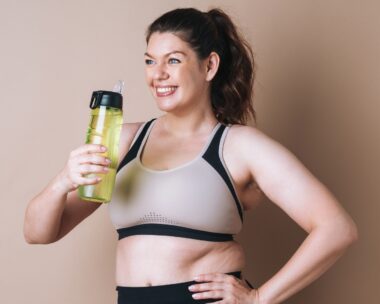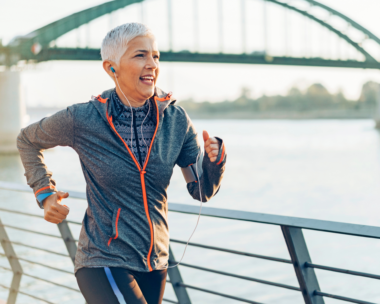As the health and wellness industry gets bigger and bigger, and the trends start arriving thick and fast, it can be almost impossible to know what solutions will work for you. What if there was a way to find out exactly which exercise and diet suit your body? No more guesswork, no more trial and error, no more feeling overwhelmed in the face of so many options. Welcome to the future of health: where you can now test your DNA and obtain your own personalised wellness plan.
The idea behind these DNA tests is simple: there are 45 genes that are believed to have an effect on how we respond to diet and exercise. The science is still relatively new – and scientists are still divided on whether or not the tests can be effective – but it is definitely a growing market.
Up until now, it’s really only been the domain for professional athletes who are looking to ‘hack’ their body to get smarter workouts and faster results. But by making the tests available to anyone willing to shell out $599 for the full process, it’s a whole new world for the health-curious who are looking to find out more about what foods and workouts work for and against their bodies.
Brendon Tod is a Kiwi clinical exercise physiologist and the creator of the rehabilitation and wellbeing company Proactive, which has brought DNAFit to New Zealand. Tod believes getting a scientific approach to wellness is the way of the future – quicker, easier and less dispiriting than making your way through a raft of contradictory expert opinions.
“This is a shortcut. It gives you more information about how your physiology will respond so you can use that to inform the choices you have. We’ve had a lot of athletes do this; we’ve also had a lot of people who just want to become healthier.”

Tod also believes because the advice you receive about your body is so personalised, the people who go through the DNAFit process see results faster than those who embark on a new lifestyle without the inside scoop. But he argues against seeing it as a quick fix.
“You’re after long-term effects, really. Your genes don’t change, but your choices around how you eat and exercise can.” By bringing some science into the mix and finding out your body’s preferences, you’re basically delivered a Wellbeing for Dummies guide to your own health.
One of my greatest and most irrational fears has been that one day I’ll have to run a marathon, so you can probably at this stage tell I’m not actually a professional athlete. So what do I, a humble, moderately active journalist whose main health goal is staving off obesity, have to gain from this serious sports-person test? Well, now that I’m in my 30s I’ve found food is becoming more of a foe than a friend. My digestion is all over the place, my eczema flares up for no reason, I feel sluggish after some foods and just plain sick after others.
Also, there’s something fascinating and narcissistic about being given a blueprint to your body’s inner workings so you can become Your Best Self. So I get the kit, do a swab around my mouth, which gets sent to the UK for analysis, and await my fitness future.
In order to get the most from the test, Tod cautions that those involved must already be ‘eating clean’ by avoiding processed foods and have a good base level of exercise in their lives. I had been quietly smug about this – as someone who also used to write for Good Health Choices, I was well informed on my wholefoods and wellness. I had already made the switch from rice to quinoa, toast to porridge and exercise three times a week with a combination of yoga, dancing and walking. I was ready to get a gold star next to my name. But it was not to be.
Athletic types may find the workout results more interesting, but for me and my weird, unexplained intolerances, it was the food section that was a total game changer. You find out if you have low, medium or high fat sensitivity and carb sensitivity.
I am the first person Tod has seen who has medium sensitivity to both carbohydrates and fats, which means I fall into the ‘poor bastards’ (his words) category of the diet section where I have to reduce my intake of both. I’m also medium on the coeliac predisposition scale, which means even my healthy carbohydrate choices of quinoa and oats are too much on a daily basis. Oh, and I have a version of the FTO gene (nicknamed ‘the fat gene’), which carries some risk of obesity.

“You’ll see those skinny people that can always stay fit and healthy without doing exercise,” Tod says. “They’re probably different to this. It just means that exercise needs to be a part of your life for the rest of your life.”
I knew I wasn’t a naturally thin person but it’s really something to have that confirmed by science. Tod drives home the point with my diet choices, saying it’s crucial to managing my weight.
“For some people it’s not so much about calorie intake… but for you it is.” It’s hard to argue that cheese is an important part of your overall value system when you have it printed in black and white that your present and future thighs are at the mercy of your malevolent fat gene.
That’s not all. It’s almost like Tod has looked deep into my soul and sensed my innermost fear when he delivers this fitness bombshell: my body is suited to long-distance running.
And when he talks me through my VO2 levels – how much oxygen capacity your body has – the fact I have a low risk of injury and that my body doesn’t get inflamed easily, an interesting picture begins to develop. Could I secretly be harbouring an athletic body underneath layers of mostly decorative muscle?
“Everyone has that potential,” Tod explains. “When you look at the research, your genes will account for between 30 and 50% of who you are. The rest of it is lifestyle. The more we know about our genetic makeup, the more we can make informed lifestyle choices.”
In order to work to my full potential, he recommends I step up my thrice-weekly workouts and aim for four to five times a week instead. Luckily running doesn’t have to be a part of it – he drily comments that my overwhelming hatred of jogging is more powerful than my genetics – but my exercises must be medium-to-hard intensity for longer, as short workouts won’t work for me.
Putting it into practice
So no carbohydrates, limited fat, and working out four times a week. When will there be good news? Well, turns out I process alcohol and coffee well, which is not to be sneezed at. The week after my meeting with Tod, I kiss goodbye to my quinoa and start putting all this into practice.
I go straight to the heart of the beast – the Les Mills across from my work – and sign up. They talk me through the options that best suit my body preferences for medium intensity, hour-long classes and suggest Body Jam (energetic dancing) and Body Combat (energetic fighting the air). I cut all carbs out of my normal daily meals, switching out quinoa for more vegetables, and oats for eggs. I am basically a lady Rocky montage, in brightly coloured tights, for the next three months.
And it works. My stomach starts feeling happier within days, I have more energy and I – a hardened anti-gym person – click immediately with my Les Mills classes because they play to my strengths. There is no trial and error, everything works. This fits with Tod’s other clients, he says.
“You get responses a little bit faster and you stick to it longer. You’ll probably notice improvements faster than anything else.”
It is possibly – probably – psychosomatic, but when the Body Combat instructor belts out “ENDURANCE! ENDURANCE!”, part of my brain perks up and goes, “That’s me, I have that!” which is a new feeling for someone who used to get lapped in school cross-country.
Because my carbohydrate intake is limited, I don’t waste my time with quinoa anymore. I’d much rather have the occasional delicious sandwich or hot fries than bother with boring ‘healthy carb’ quinoa, if it’s not going to be great for me anyway. Before long, I have to buy a smaller size of brightly coloured tights and become so impressed by my new biceps that I get caught staring at them by my colleagues.
Moving forward
When you have started a new eating regime, lost some weight or begin a new fitness class, there can often be a dark part of your brain that thinks: what happens when this ends? You lose interest in the class, you get sick of the eating plan, the weight creeps back on. And three months into my New Best Self, I fall off a step, bust my foot and have to skip all exercise for a month – which coincides with the summer holidays, and a lot of wine and bread and cheese.
But for the first time in my adult life, I don’t feel the falling-off-the-wagon fear. I know now exactly what I need to do and eat to keep my body fighting fit and it feels like I’m equipped with a fool-proof set of tools I can use for the rest of my life.
So while it may never be my DNA destiny to run a marathon, the knowledge that I could be – and now am – a fit person is enough for me.
Words: Emma Clifton
For more from NEXT, follow us on Facebook and Instagram here.




